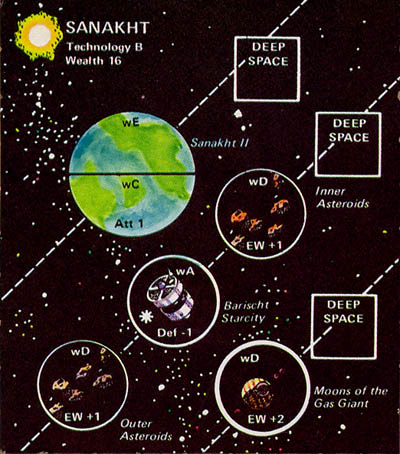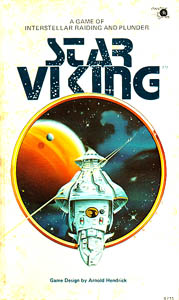Game Main > Star Viking

ρ=Σ+Ψ
Star Viking
designed by Arnold Hendrick
1981, Heritage USA/Dwarfstar Game

Star Viking is played on a series of cardboard tiles, instead of a hexmap.
Instead of hexes, there are sectors. The white squares and circles
on the tiles are sectors, as are the two halves of the blue planet. The
playing counters are placed in sectors. The three kinds of sectors are
Atmospheric (on the blue planets), Deep Space (as labeled),
and Vacuum (everything else).
The sectors are along orbits. There are three orbits above, shown by
the diagonal dotted lines. Each orbit ends with a Deep Space sector.
The game gem is the Deep Space sector. The importance of the Deep Space
sector is that if a unit is moving from one sector to a sector in a different
orbit, the first sector entered must be the deep space sector. This
allows units to guard orbits against enemy incursions by garrisoning the
deep space sector.
Each unit (ship or army unit) has a movement type:
-
Starship movement: Unit may move from any sector to any sector,
may be placed in any kind of sector. May hyperjump to another tile.
-
Interplanetary movement: Unit may move from any sector to any sector,
may be placed in any kind of sector. Cannot hyperjump, must be carried
as cargo by hyper capable ship.
-
Limited Interplanetary movement: Unit may move from any sector to
any sector within a given orbit, but may not change orbits. Unit must be
carried as cargo to change orbits. Maybe placed in any kind of sector.
-
Vacuum: Unit may only move between touching sectors ( i.e.,
sectors composing a single planet). Basically the unit is an army unit
in space suits. May not be placed in Deep Space sectors.
-
Atmospheric: Unit may only move between touching sectors (
i.e., sectors composing a single planet). Basically the unit is
an army unit without space suits. May only be placed in atmospheric sectors.



